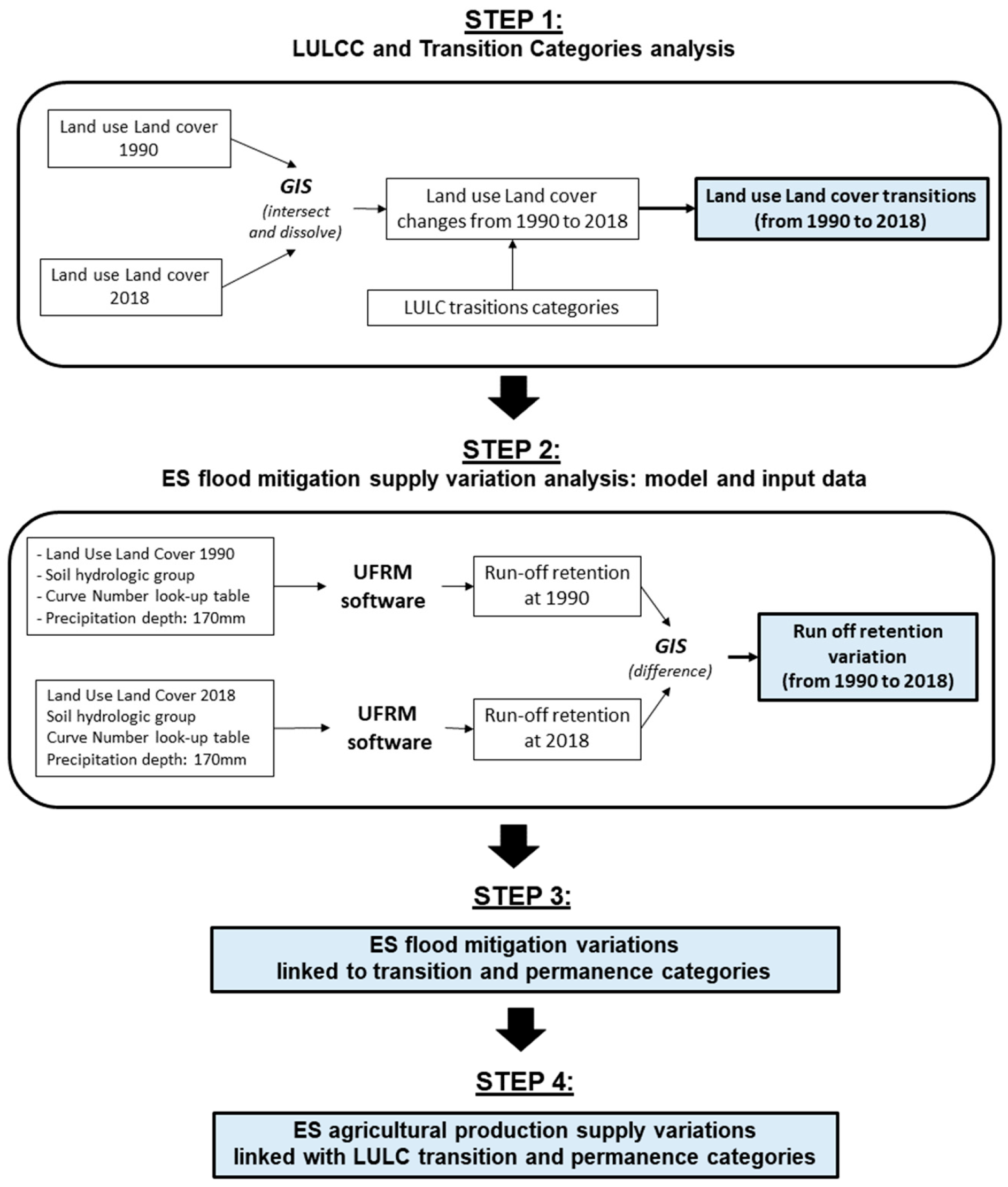Linking Flood Risk Mitigation and Food Security: An Analysis of Land-Use Change in the Metropolitan Area of Rome
Abstract
1. Introduction
2. Materials and Methods
2.1. Study Area
2.2. Methodological Framework
2.3. LULCC and Transition Categories Analysis (Step 1)
2.4. ES Flood Mitigation Supply Variation Analysis: Model and Input Data (Step 2)
2.4.1. Land-Use and Land-Cover Raster
2.4.2. Hydrologic Soil Groups
2.4.3. Curve Number
2.4.4. Rainfall Depth
2.5. ES Flood Mitigation Variations Linked to Transition and Permanence Categories (Step 3)
2.6. ES Agricultural Production Variation Linked to Transition and Permanence Categories (Step 4)
3. Results
3.1. Transition Category Analysis
3.2. ES Supply Variation Analysis
3.3. ES Supply Variation Associated with LULC Transition Categories
- Transformations from arable land (211 CLC class) to urbanized land-uses, such as discontinuous residential areas (112 CLC class) and industrial/commercial areas (121 CLC class) (5464 ha);
- Transitions from complex agricultural systems (242 and 243 CLC classes) to discontinuous urban areas (112 CLC class) (3336 ha).
3.4. Variation of ES Agricultural Production
4. Discussion
5. Conclusions
Author Contributions
Funding
Conflicts of Interest
Appendix A
| CLC Classes | Hydrologic Soil Groups | |||
|---|---|---|---|---|
| A | B | C | D | |
| 111 - Continuous urban fabric | 89 | 92 | 94 | 95 |
| 112 - Discontinuous urban fabric | 77 | 85 | 90 | 92 |
| 121 - Industrial or commercial units | 81 | 88 | 91 | 93 |
| 122 - Road and rail networks and associated territories | 98 | 98 | 98 | 98 |
| 123 - Port areas | 98 | 98 | 98 | 98 |
| 124 - Airports | 98 | 98 | 98 | 98 |
| 131 - Mineral extraction sites | 76 | 85 | 89 | 91 |
| 132 - Landfills | 81 | 88 | 91 | 93 |
| 133 - Construction sites | 77 | 86 | 91 | 94 |
| 141 - Urban green areas | 49 | 69 | 79 | 84 |
| 142 - Sport and leisure facilities | 68 | 79 | 86 | 89 |
| 211 - Non-irrigated arable land | 61 | 73 | 81 | 84 |
| 212 - Permanently irrigated land | 67 | 78 | 85 | 89 |
| 213 - Rice paddies | 62 | 71 | 78 | 81 |
| 221 - Vineyards | 76 | 85 | 90 | 93 |
| 222 - Orchards and minor fruits | 43 | 65 | 76 | 82 |
| 223 - Olive groves | 43 | 65 | 76 | 82 |
| 231 - Pastures | 49 | 69 | 79 | 84 |
| 241 - Annual crops associated withpermanent crops | 61 | 73 | 81 | 84 |
| 242 – Complex cultivations patterns | 61 | 73 | 81 | 84 |
| 243 - Land principally occupied by agriculture, with significant areas of natural vegetation | 61 | 73 | 81 | 84 |
| 244 - Agro-forestry areas | 43 | 65 | 76 | 82 |
| 311 - Broad-leaved forests | 36 | 60 | 73 | 79 |
| 312 - Coniferous forests | 36 | 60 | 73 | 79 |
| 313 - Mixed forests | 36 | 60 | 73 | 79 |
| 321 - Natural grassland | 49 | 69 | 79 | 84 |
| 322 - Heathland and scrubland | 49 | 69 | 79 | 84 |
| 323 - Sclerophyllous vegetation | 35 | 56 | 70 | 77 |
| 324 - Transition woodland/shrubs | 35 | 56 | 70 | 77 |
| 331 - Beaches, dunes, and sand flats | 46 | 65 | 77 | 82 |
| 332 - Bare rock | 96 | 96 | 96 | 96 |
| 333 - Sparsely vegetated areas | 63 | 77 | 85 | 88 |
| 334 - Burnt areas | 63 | 77 | 85 | 88 |
| 335 - Glaciers and perennial snows | 98 | 98 | 98 | 98 |
| 411 - Inland marshes | 98 | 98 | 98 | 98 |
| 412 - Bogs | 98 | 98 | 98 | 98 |
| 421 - Salt marshes | 98 | 98 | 98 | 98 |
| 422 - Salines | 98 | 98 | 98 | 98 |
| 423 – Intertidal flats | 98 | 98 | 98 | 98 |
| 511 – Water courses | 98 | 98 | 98 | 98 |
| 512 – Water bodies | 98 | 98 | 98 | 98 |
| 521 – Coastal lagoons | 98 | 98 | 98 | 98 |
| 522 – Estuaries | 98 | 98 | 98 | 98 |
| 523 – Sea and ocean | 98 | 98 | 98 | 98 |
Appendix B
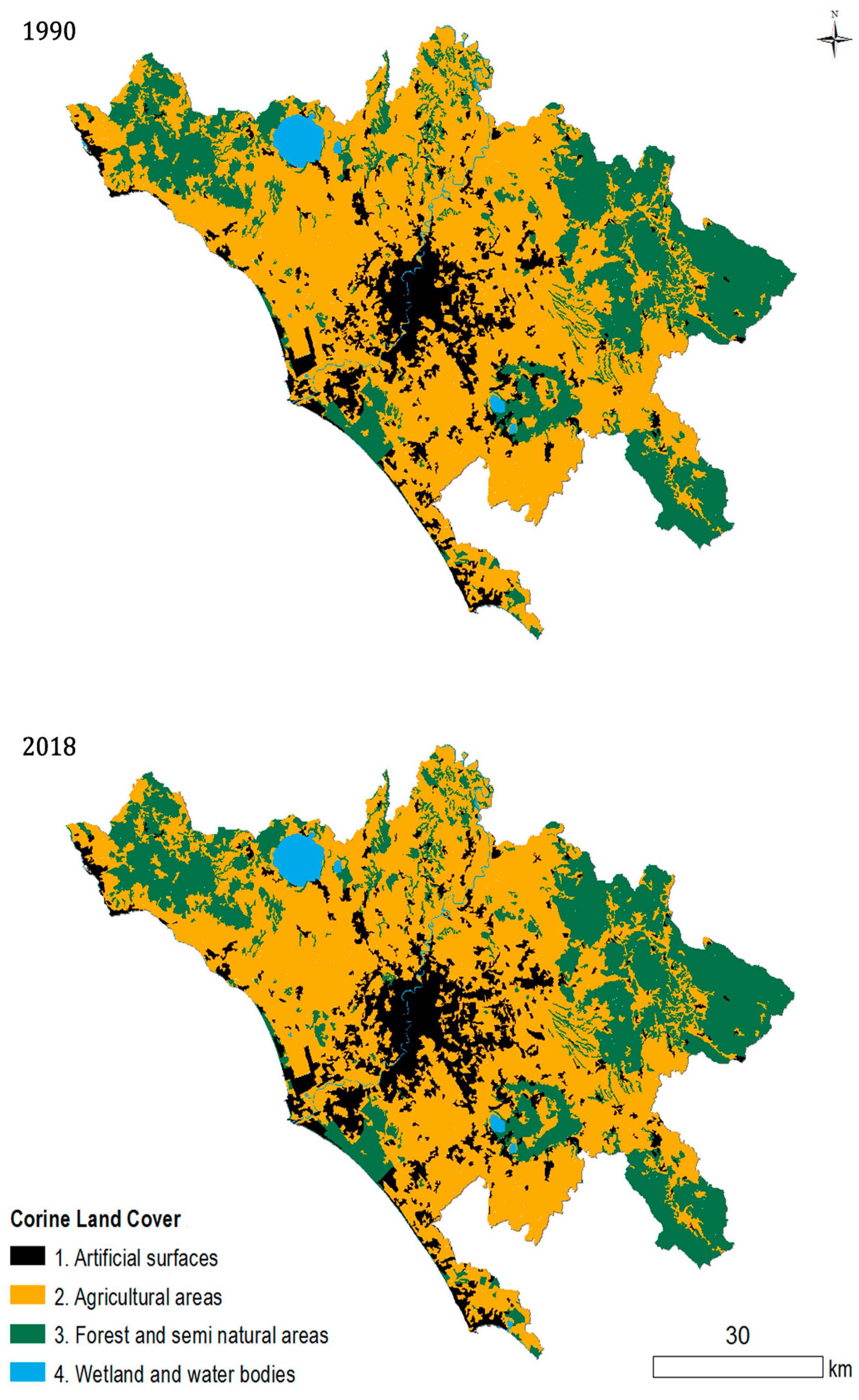
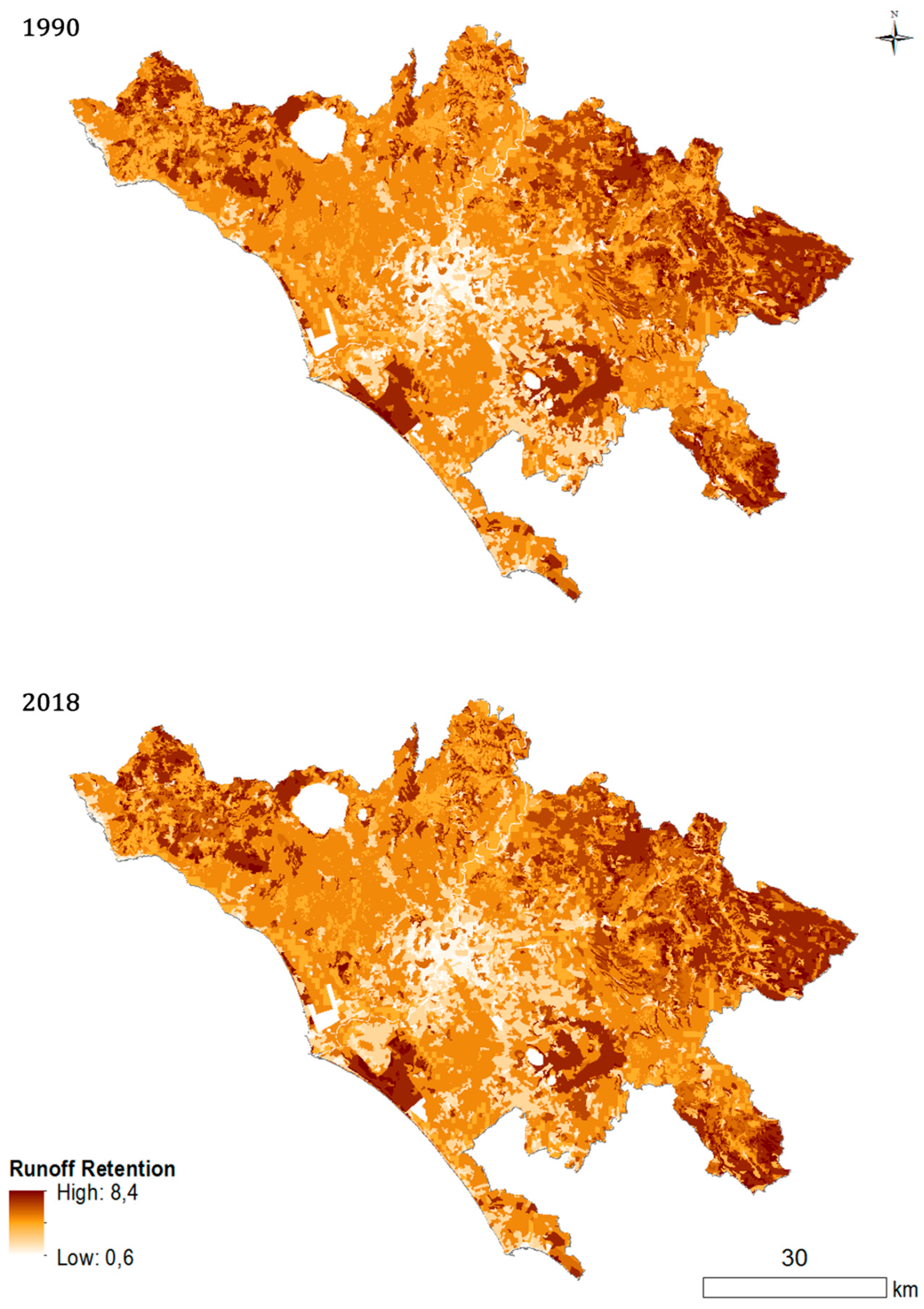
References
- Rockstrom, J.; Steffen, W.; Noone, K.; Persson, A.; Chapin, F.S., III; Lambin, E.F.; Lenton, T.M.; Scheffer, M.; Folke, C.; Schellnhuber, H.J.; et al. A safe operating space for humanity: Identifying and quantifying planetary boundaries that must not be transgressed could help prevent human activities from causing unacceptable environmental change, argue Johan Rockstrom and colleagues. Nature 2009, 461, 472–476. [Google Scholar] [CrossRef] [PubMed]
- Steffen, W.; Richardson, K.; Rockström, J.; Cornell, S.E.; Fetzer, I.; Bennett, E.M.; Biggs, R.; Carpenter, S.R.M.; De Vries, W.; De Wit, C.A.; et al. Planetary boundaries: Guiding human development on a changing planet. Science 2015, 347, 1259855. [Google Scholar] [CrossRef] [PubMed]
- UN DESA. The Sustainable Development Goals Report 2022; UN DESA: New York, NY, USA, 2022. [Google Scholar]
- Ruddiman, W.F. The Anthropocene. Annu. Rev. Earth Planet. Sci. 2013, 41, 45–68. [Google Scholar] [CrossRef]
- United States Nations Office for Disaster Risk Reduction (UNISDR). Words into Action Guidelines: National Disaster Risk Assessment Hazard Specific Risk Assessment 4, Flood Hazard and Risk Assessment; UNISDR: Geneva, Switzerland, 2017. [Google Scholar]
- Centre for Research on the Epidemiology of Disasters (CRED). Disaster Year in Review 2019; CRED: Bengaluru, India, 2020. [Google Scholar]
- Data. Available online: https://www.preventionweb.net/news/mitigating-impact-climate-change-and-flooding-italy (accessed on 11 December 2022).
- ISPRA. Landslides and floods in Italy: Hazard and Risk Indicators; Summary Report. 287bis/18; ISPRA: Rome, Italy, 2018; ISBN 978-88-448-0934-8. [Google Scholar]
- Anelli, D.; Tajani, F.; Ranieri, R. Urban resilience against natural disasters: Mapping the risk with an innovative indicators-based assessment approach. J. Clean. Prod. 2022, 371, 133496. [Google Scholar] [CrossRef]
- Horton, R.E. Analysis of runoff-plat experiments with varying infiltration-capacity. Eos Trans. Am. Geophys. Union 1939, 20, 693–711. [Google Scholar] [CrossRef]
- Mangala, O.S.; Toppo, P.; Ghoshal, S. Study of infiltration capacity of different soils. Int. J. Trend Res. Dev. 2016, 3, 388–390. [Google Scholar]
- Huffman, R.L.; Fangmeier, D.D.; Elliot, W.J.; Workman, S.R.; Schwab, G.O. Chapter 5: Infiltration and Runoff. In Soil and Water Conservation Engineering, 7th ed.; Copyright American Society of Agricultural and Biological Engineers; ASABE: St. Joseph, MI, USA, 2013; pp. 81–113. ISBN 1-892769-86-7. [Google Scholar] [CrossRef]
- Sugianto, S.; Deli, A.; Miswar, E.; Rusdi, M.; Irham, M. The Effect of Land Use and Land Cover Changes on Flood Occurrence in TeunomWatershed, Aceh Jaya. Land 2022, 11, 1271. [Google Scholar] [CrossRef]
- Liu, Y.B.; De Smedt, F.; Hoffmann, L.; Pfister, L. Assessing land use impacts on flood processes in complex terrain by using GIS and modeling approach. Environ. Model. Assess. 2005, 9, 227–235. [Google Scholar] [CrossRef]
- Quagliolo, C.; Comino, E.; Pezzoli, A. Experimental Flash Floods Assessment Through Urban Flood Risk Mitigation (UFRM) Model: The Case Study of Ligurian Coastal Cities. Front. Water 2021, 3, 663378. [Google Scholar] [CrossRef]
- Levavasseur, F.; Bailly, J.S.; Lagacherie, P.; Colin, F.; Rabotin, M. Simulating the effects of spatial configurations of agricultural ditch drainage networks on surface runoff from agricultural catchments. Hydrol. Process. 2012, 26, 3393–3404. [Google Scholar] [CrossRef]
- Irham, M.; Ilhamsyah, Y.; Deli, A.; Syahreza, S. Is flash flood cycle? A preliminary climate study on Teunom fluvial system. Conf. Ser. Earth Environ. Sci. 2019, 273, 012001. [Google Scholar] [CrossRef]
- Abdullah, H.M.; Islam, I.; Miah, M.G.; Ahmed, Z. Quantifying the spatiotemporal patterns of forest degradation in a fragmented, rapidly urbanizing landscape: A case study of Gazipur, Bangladesh. Remote Sens. Appl. Soc. Environ. 2019, 13, 457–465. [Google Scholar] [CrossRef]
- Bradshaw, C.J.; Sodhi, N.S.; Peh, K.S.H.; Brook, B.W. Global evidence that deforestation amplifies flood risk and severity in the developing world. Glob. Chang. Biol. 2007, 13, 2379–2395. [Google Scholar] [CrossRef]
- Antonio, P.; Carandang, L.A.B.; Dolom, P.C.; Garcia, L.N.; Magdalena, M.; Villanueva, B.; Espiritu, N.O. Analysis of Key Drivers of Deforestation and Forest Degradation in the Philippines; Deutsche Gesellschaft für Internationale Zusammenarbeit (GIZ) GmbH: Manila, Philippine, 2013. [Google Scholar]
- Burkhard, B.; Kroll, F.; Müller, F.; Windhorst, W. Landscapes’ Capacities to Provide Ecosystem Services—A Concept for Land-Cover Based Assessments. Landsc. Online 2009, 15, 1–22. [Google Scholar] [CrossRef]
- Clark, C. Deforestation and floods. Environ. Conserv. 1987, 14, 67–69. [Google Scholar] [CrossRef]
- Barral, M.P.; Laterra, P.; Maceira, N. Flood mitigation ecosystem service in landscapes of Argentina’s Pampas: Identifying winning and losing farmers. J. Environ. Manag. 2019, 240, 168–176. [Google Scholar] [CrossRef]
- Barbedo, J.; Miguez, M.; Van Der Horst, D.; Marins, M. Enhancing ecosystem services for flood mitigation: A conservation strategy for peri-urban landscapes? Ecol. Soc. 2014, 19, 54. [Google Scholar] [CrossRef]
- Eigenbrod, F.; Bell, V.A.; Davies, H.N.; Heinemeyer, A.; Armsworth, P.R.; Gaston, K.J. The impact of projected increases in urbanization on ecosystem services. Proc. R. Soc. B Biol. Sci. 2011, 278, 3201–3208. [Google Scholar] [CrossRef]
- Kahane, R.; Hodgkin, T.; Jaenicke, H.; Hoogendoorn, C.; Hermann, M.; Hughes, J.D.A.; Padulosi, S.; Looney, N. Agrobiodiversity for food security, health and income. Agron. Sustain. Dev. 2013, 33, 671–693. [Google Scholar] [CrossRef]
- Li, X.; Siddique, K.H.M. Future Smart Food: Harnessing the Potential of Neglected and Underutilized Species for Zero Hunger. Matern. Child Nutr. 2020, 16, e13008. [Google Scholar] [CrossRef]
- Taromideh, F.; Fazloula, R.; Choubin, B.; Emadi, A.; Berndtsson, R. Urban Flood-Risk Assessment: Integration of Decision-Making and Machine Learning. Sustainability 2022, 14, 4483. [Google Scholar] [CrossRef]
- Wijayarathne, D.B.; Coulibaly, P. Identification of hydrological models for operational flood forecasting in St. John’s, Newfoundland, Canada. J. Hydrol. Reg. Stud. 2020, 27, 100646. [Google Scholar] [CrossRef]
- Unduche, F.; Tolossa, H.; Senbeta, D.; Zhu, E. Evaluation of four hydrological models for operational flood forecasting in a Canadian Prairie watershed. Hydrol. Sci. J. 2018, 63, 1133–1149. [Google Scholar] [CrossRef]
- Barredo, J.I.; Engelen, G. Land use scenario modeling for flood risk mitigation. Sustainability 2010, 2, 1327–1344. [Google Scholar] [CrossRef]
- Woolley, R.; Marsell, R.; Grover, N. Cloudburst Floods in Utah. 1850–1938; US Government Printing Office: Washington, DC, USA, 1946. Available online: http://pubs.usgs.gov/wsp/0994/report.pdf (accessed on 15 December 2022).
- Brunetta, G.; Ceravolo, R.; Barbieri, C.A.; Borghini, A.; de Carlo, F.; Mela, A.; Beltramo, S.; Longhi, A.; De Lucia, G.; Ferraris, S.; et al. Territorial resilience: Toward a proactive meaning for spatial planning. Sustainability 2019, 11, 2286. [Google Scholar] [CrossRef]
- Faisal, A.A.; Kafy, A.A.; Roy, S. Integration of Remote Sensing and GIS Techniques for Flood Monitoring and Damage Assessment: A Case Study of Naogaon District, Bangladesh. Remote Sens. GIS 2018, 7, 236. [Google Scholar] [CrossRef]
- Liping, C.; Yujun, S.; Saeed, S. Monitoring and predicting land use and land cover changes using remote sensing and GIS techniques—A case study of a hilly area, Jiangle, China. PLoS ONE 2018, 13, e0200493. [Google Scholar] [CrossRef]
- Natural Capital Project. InVEST. University of Stanford. Available online: https://naturalcapitalproject.stanford.edu/software/invest (accessed on 30 September 2022).
- Recanatesi, F.; Petroselli, A. Land Cover Change and flood risk in a peri-urban environment of the Metropolitan area of Rome (Italy). Water Resour. Manag. 2020, 34, 4399–4413. [Google Scholar] [CrossRef]
- Kadaverugu, A.; Rao, C.N.; Viswanadh, G.K. Quantification of flood mitigation services by urban green spaces using InVEST model: A case study of Hyderabad city, India. Model. Earth Syst. Environ. 2021, 7, 589–602. [Google Scholar] [CrossRef]
- Salata, S.; Arslan, B. Designing with Ecosystem Modelling: The Sponge District Application in Izmir, Turkey. Sustainability 2022, 14, 3420. [Google Scholar] [CrossRef]
- Apollonio, C.; Balacco, G.; Novelli, A.; Tarantino, E.; Piccinni, A.F. Land use change impact on flooding areas: The case study of Cervaro Basin (Italy). Sustainability 2016, 8, 996. [Google Scholar] [CrossRef]
- Padró, R.; La Rota-Aguilera, M.J.; Giocoli, A.; Cirera, J.; Coll, F.; Pons, M.; Pino, J.; Pili, S.; Tarik, S.; Gara, V.; et al. Assessing the sustainability of contrasting land use scenarios through the Socioecological Integrated Analysis (SIA) of the metropolitan green infrastructure in Barcelona. Landsc. Urban Plan. 2020, 203, 103905. [Google Scholar] [CrossRef] [PubMed]
- Magnaghi, A.; Fanfani, D. Patto Città Campagna: Un Progetto di Bioregione Urbana Per la Toscana Centrale; Alinea Editrice: Firenze, Italy, 2010. [Google Scholar]
- Evans, D.L.; Falagán, N.; Hardman, C.A.; Kourmpetli, S.; Liu, L.; Mead, B.R.; Davies, J.A.C. Ecosystem service delivery by urban agriculture and green infrastructure—A systematic review. Ecosyst. Serv. 2022, 54, 101405. [Google Scholar] [CrossRef]
- Russo, A.; Escobedo, F.J.; Cirella, G.T.; Zerbe, S. Edible green infrastructure: An approach and review of provisioning ecosystem services and disservices in urban environments. Agric. Ecosyst. Environ. 2017, 242, 53–66. [Google Scholar] [CrossRef]
- Marando, F.; Salvatori, E.; Sebastiani, A.; Fusaro, L.; Manes, F. Regulating Ecosystem Services and Green Infrastructure: Assessment of Urban Heat Island effect mitigation in the municipality of Rome, Italy. Ecol. Model. 2019, 392, 92–102. [Google Scholar] [CrossRef]
- Colantoni, A.; Pili, S.; Mosconi, E.M.; Poponi, S.; Cecchini, M.; Doria, P.; Salvati, L. Metropolitan Agriculture, socio-demographic dynamics and the Food-City relationship in southern Europe. Curr. Policy Econ. Eur. 2017, 28, 301–324. [Google Scholar]
- Landor-Yamagata, J.L.; Kowarik, I.; Fischer, L.K. Urban foraging in Berlin: People, plants and practices within the metropolitan green infrastructure. Sustainability 2018, 10, 1873. [Google Scholar] [CrossRef]
- Lin, B.B.; Philpott, S.M.; Jha, S.; Liere, H. Urban Agriculture as a Productive Green Infrastructure for Environmental and Social Well-Being. In Greening Cities; Springer: Singapore, 2017; pp. 155–179. [Google Scholar]
- Khan, M.M.; Akram, M.T.; Janke, R.; Qadri, R.W.K.; Al-Sadi, A.M.; Farooque, A.A. Urban horticulture for food secure cities through and beyond COVID-19. Sustainability 2020, 12, 9592. [Google Scholar] [CrossRef]
- Food and Agriculture Organization. State of World Food Insecurity; Food and Agriculture Organization: Rome, Italy, 2006; ISBN 92-5-105580-7. [Google Scholar]
- Richardson, R.B. Ecosystem services and food security: Economic perspectives on environmental sustainability. Sustainability 2010, 2, 3520–3548. [Google Scholar] [CrossRef]
- Gardi, C.; Panagos, P.; Van Liedekerke, M.; Bosco, C.; De Brogniez, D. Land take and food security: Assessment of land take on the agricultural production in Europe. J. Environ. Plan. Manag. 2015, 58, 898–912. [Google Scholar] [CrossRef]
- Shen, T.; Jiao, P.; Yuan, H.; Su, H. Effects of Flooding Duration and Growing Stage on Soybean Growth Based on a Multi-Year Experiment. Sustainability 2022, 15, 738. [Google Scholar] [CrossRef]
- Pais, I.P.; Moreira, R.; Semedo, J.N.; Ramalho, J.C.; Lidon, F.C.; Coutinho, J.; Maçãs, B.; Scotti-Campos, P. Wheat Crop under Waterlogging: Potential Soil and Plant Effects. Plants 2022, 12, 149. [Google Scholar] [CrossRef] [PubMed]
- Al-Jawaldeh, A.; Nabhani, M.; Taktouk, M.; Nasreddine, L. Climate Change and Nutrition: Implications for the Eastern Mediterranean Region. Int. J. Environ. Res. Public Health 2022, 19, 17086. [Google Scholar] [CrossRef]
- Gaviglio, A.; Marescotti, M.E.; Demartini, E.; Corradini, A. Flood Damage on Dairy Farms: A What-If Analysis to Assess Economic Losses. Water 2022, 14, 3984. [Google Scholar] [CrossRef]
- Douglas, I. Climate change, flooding and food security in south Asia. Food Secur. 2009, 1, 127–136. [Google Scholar] [CrossRef]
- Gregory, P.J.; Ingram, J.S.; Brklacich, M. Climate change and food security. Philos. Trans. R. Soc. B Biol. Sci. 2005, 360, 2139–2148. [Google Scholar] [CrossRef] [PubMed]
- Schmidhuber, J.; Tubiello, F.N. Global food security under climate change. Proc. Natl. Acad. Sci. USA 2007, 104, 19703–19708. [Google Scholar] [CrossRef] [PubMed]
- Brunori, G.; Malandrin, V.; Rossi, A. Trade-off or convergence? The role of food security in the evolution of food discourse in Italy. J. Rural Stud. 2013, 29, 19–29. [Google Scholar] [CrossRef]
- Vaarst, M.; Escudero, A.G.; Chappell, M.J.; Brinkley, C.; Nijbroek, R.; Arraes, N.A.; Andreasen, L.; Gattinger, A.; De Almeida, G.F.; Bossio, D.; et al. Exploring the concept of agroecological food systems in a city-region context. Agroecol. Sustain. Food Syst. 2018, 42, 686–711. [Google Scholar] [CrossRef]
- Millennium Ecosystem Assessment (MEA). Ecosystems and Human Well-Being: Synthesis; Island Press: Washington, DC, USA, 2005. [Google Scholar]
- AAVV. Roma, Metropoli al Futuro. Innovativa, Sostenibile, Inclusiva. Piano Strategico Metropolitano di Roma Capitale 2022–2024. 2022. Available online: https://static.cittametropolitanaroma.it/uploads/Trasp_Delibera_76-15_14_12_2022_DPT0400.pdf (accessed on 20 January 2023).
- Marino, D.; Bernaschi, D.; Cimini, A.; D’Amico, G.; Gallo, G.; Giovanelli, G.; Giustozzi, D.; Kollamparambil, A.; Lirosi, L.; Mazzocchi, G.; et al. Atlante del Cibo. Uno Strumento per le Politiche locali del Cibo. In Città metropolitana di Roma Capitale; CURSA: Roma, Italy, 2022; ISBN 9788894227239. [Google Scholar]
- Pili, S.; Grigoriadis, E.; Carlucci, M.; Clemente, M.; Salvati, L. Towards sustainable growth? A multi-criteria assessment of (changing) urban forms. Ecol. Indic. 2017, 76, 71–80. [Google Scholar] [CrossRef]
- Cellamare, C. Fuori Raccordo: Abitare L’altra Roma; Donzelli: Rome, Italy, 2016. [Google Scholar]
- Pili, S.; Serra, P.; Salvati, L. Landscape and the city: Agro-forest systems, land fragmentation and the ecological network in Rome, Italy. Urban For. Urban Green. 2019, 41, 230–237. [Google Scholar] [CrossRef]
- Lentini, A.; Meddi, E.; Galve, J.P.; Papiccio, C.; La Vigna, F. Preliminary identification of areas suitable for Sustainable Drainage Systems and Managed Aquifer Recharge to mitigate stormwater flooding phenomena in Rome (Italy). Acque Sotter. Ital. J. Groundw. 2022, 11, 43–53. [Google Scholar] [CrossRef]
- Calenda, G.; Mancini, C.P.; Volpi, E. Selection of the probabilistic model of extreme floods: The case of the River Tiber in Rome. J. Hydrol. 2009, 371, 1–11. [Google Scholar] [CrossRef]
- Nardi, F.; Annis, A.; Biscarini, C. Urbanization impact on flood hydrology within the city of Rome. J. Flood Risk Manag. 2018, 11, S594–S603. [Google Scholar] [CrossRef]
- Di Baldassarre, G.; Saccà, S.; Aronica, G.T.; Grimaldi, S.; Ciullo, A.; Crisci, M. Human-flood interactions in Rome over the past 150 years. Adv. Geosci. 2017, 44, 9–13. [Google Scholar] [CrossRef]
- ISPRA. (n.d.) SINAnet—Uso, Copertura e Consumo di Suolo. 2022. Available online: https://groupware.sinanet.isprambiente.it/uso-copertura-e-consumo-di-suolo/library/copertura-del-suolo/corine-land-cover/ (accessed on 28 September 2022).
- Battisti, C.; Mandolini, R. La comunità ornitica nidificante in un settore residuale della Campagna romana (corridoio tra le Riserve naturali ‘Valle dei Casali’ e ‘Tenuta dei Massimi’; Roma, Italia centrale). Alula 2018, 25, 1–9. [Google Scholar]
- Pili, S.; Mavrakis, A.; Santeriano, A.; Serra, P.; Salvati, L. Metropolitan agriculture: Socio–demographic dynamics, urban growth and food–city relationship in the Mediterranean Basin. Boll. Della Soc. Geogr. Ital. 2017, 10, 77–91. [Google Scholar]
- Assefa, W.W.; Eneyew, B.G.; Wondie, A. The impacts of land-use and land-cover change on wetland ecosystem service values in peri-urban and urban areas of Bahir Dar City, Upper Blue Nile Basin, Northwestern Ethiopia. Ecol. Process. 2021, 10, 39. [Google Scholar] [CrossRef]
- Gashaw, T.; Tulu, T.; Argaw, M.; Worqlul, A.W. Evaluation and prediction of land use/land cover changes in the Andassa watershed, Blue Nile Basin, Ethiopia. Environ. Syst. Res. 2017, 6, 17. [Google Scholar] [CrossRef]
- Berihun, M.L.; Tsunekawa, A.; Haregeweyn, N.; Meshesha, D.T.; Adgo, E.; Tsubo, M.; Masunaga, T.; Fenta, A.A.; Sultan, D.; Yibeltal, M. Exploring land use/land cover changes, drivers and their implications in contrasting agro-ecological environments of Ethiopia. Land Use Policy 2019, 87, 104052. [Google Scholar] [CrossRef]
- Kindu, M.; Schneider, T.; Teketay, D.; Knoke, T. Changes of ecosystem service values in response to land use/land cover dynamics in Munessa-Shashemene landscape of the Ethiopian highlands. Sci. Total Environ. 2016, 547, 137–147. [Google Scholar] [CrossRef] [PubMed]
- Kavhu, B.; Mashimbye, Z.E.; Luvuno, L. Detecting Connectivity and Spread Pathways of Land Use/Cover Change in a Transboundary Basin Based on the Circuit Theory. Geomatics 2022, 2, 518–539. [Google Scholar] [CrossRef]
- Grêt-Regamey, A.; Brunner, S.H.; Kienast, F. Mountain Ecosystem Services: Who cares? Mt. Res. Dev. 2012, 32, S1. [Google Scholar] [CrossRef]
- Rodriguez, J.P.; Beard, T.D., Jr.; Bennett, E.M.; Cumming, G.S.; Cork, S.; Agard, J.; Dobson, A.P.; Peterson, G.D. Trade-offs across space, time, and ecosystem services. Ecol. Soc. 2006, 11, 28. Available online: http://www.ecologyandsociety.org/vol11/iss1/art28/ (accessed on 15 November 2022).
- Talukdar, S.; Singha, P.; Mahato, S.; Praveen, B.; Rahman, A. Dynamics of ecosystem services (ESs) in response to land use land cover (LU/LC) changes in the lower Gangetic plain of India. Ecol. Indic. 2020, 112, 106121. [Google Scholar] [CrossRef]
- Sharma, E.; Molden, D.; Rahman, A.; Khatiwada, Y.R.; Zhang, L.; Singh, S.P.; Yao, T.; Wester, P. Introduction to the Hindu Kush Himalaya Assessment. In The Hindu Kush Himalaya Assessment: Mountains, Climate Change, Sustainability and People; Wester, P., Mishra, A., Mukherji, A., Shrestha, A.B., Eds.; Springer Nature: Cham, Switzerland, 2019; pp. 1–16. [Google Scholar]
- Arowolo, A.O.; Deng, X.; Olatunji, O.A.; Obayelu, A.E. Assessing changes in the value of ecosystem services in response to land-use/land-cover dynamics in Nigeria. Sci. Total Environ. 2018, 636, 597–609. [Google Scholar] [CrossRef]
- Marino, D.; Nofroni, L.; Savelli, S. Trasformazioni e Permanenze dei Paesaggi Agrari Tradizionali Alla Scala Nazionale. Un’indagine Diacronica 1960–2012. In Congresso Scientifico SIEP-IALE; SIEP - IALE Italian Society of Landscape Ecology: Asti, Italy, 2016. [Google Scholar]
- Ross, C.W.; Prihodko, L.; Anchang, J.Y.; Kumar, S.S.; Ji, W.; Hanan, N.P. Global Hydrologic Soil Groups (HYSOGs250m) for Curve Number-Based Runoff Modeling; ORNL DAAC: Oak Ridge, TN, USA, 2018. [Google Scholar] [CrossRef]
- Castelli, F. Modellazione Idrologica Caso Pilota. Implementazione Modello Distribuito per la Toscana MOBIDIC. Addendum: Parametrizzazione HMS. Relazione Tecnica Finale. 2014. Available online: https://www.regione.toscana.it/documents/10180/12745809/Parametri_HMS.pdf/fd3b35dc-98d9-463b-aa87-ede3eaf6da89 (accessed on 5 November 2022).
- USDA—Natural Resources Conservation Service. Hydrologic Soil Groups. In National Engineering Handbook; USDA: Washington, DC, USA, 2009; Chapter 7, Part 630. Available online: https://directives.sc.egov.usda.gov/OpenNonWebContent.aspx?content=17757.wba (accessed on 15 November 2022).
- USDA. Soil Conservation Service National Engineering Handbook. In Section 4: Hydrology, Chapters 4–10; USDA: Washington, DC, USA, 1972; pp. 15-7–15-11. [Google Scholar]
- Moglen, G.E.; Sadeq, H.; Hughes, L.H.; Meadows, M.E.; Miller, J.J.; Ramirez-Avila, J.J.; Tollner, E.W. NRCS Curve Number Method: Comparison of Methods for Estimating the Curve Number from Rainfall-Runoff Data. J. Hydrol. Eng. 2022, 27, 04022023. [Google Scholar] [CrossRef]
- Ponce, V.M.; Hawkins, R.H. Runoff curve number: Has it reached maturity? J. Hydrol. Eng. 1996, 1, 11–19. [Google Scholar] [CrossRef]
- USDA—Natural Resources Conservation Service. Hydrologic Soil-Cover Complexes. In National Engineering Handbook; USDA: Washington, DC, USA, 2004; Chapter 9, Part 630. Available online: https://directives.sc.egov.usda.gov/OpenNonWebContent.aspx?content=17758.wba (accessed on 15 November 2022).
- USDA—Natural Resources Conservation Service. Urban Hydrology for Small Watersheds. In Technical Release 55 (TR-55), 2nd ed.; Natural Resources Conservation Service, Conservation Engineering Division; USDA: Washington, DC, USA, 1986. [Google Scholar]
- Stürck, J.; Poortinga, A.; Verburg, P. Mapping ecosystem services: The supply and demand of flood regulation services in Europe. Ecol. Indic. 2014, 38, 198–221. [Google Scholar] [CrossRef]
- CREA. Annuario Dell’agricoltura Italiana, In CREA—Consiglio per la Ricerca e in Agricoltura e L’analisi Dell’economia Agraria; Centro di Ricerca Politiche e Bio-Economia: Roma, Italy, 2021; Volume LXXIV. [Google Scholar]
- Bennett, E.M.; Peterson, G.D.; Gordon, L.J. Understanding relationships among multiple ecosystem services. Ecol. Lett. 2009, 12, 1394–1404. [Google Scholar] [CrossRef]
- Sansone, L.; Carroni, A.M.; Fedrizzi, M.; Santilli, E.; Pipitone, G.; Pagano, M.; Sperandio, G.; Guerrieri, M.; Puri, D.; Zaffina, F.; et al. Evaluation of environmental and economic effectiveness of the Cross Compliance 4.3 Standard ‘Maintenance of olive groves and vineyards in good vegetative conditions’. Ital. J. Agron. 2015, 10. [Google Scholar] [CrossRef]
- Marino, D.; Palmieri, M.; Marucci, A.; Pili, S. Long-term land cover changes and ecosystem services variation: Have the anthropogenic transformations degraded human well-being in Italy? Ital. Rev. Agric. Econ. 2022, 77, 7–23. [Google Scholar] [CrossRef]
- Marucci, A.; Marino, D.; Palmieri, M.; Pili, S. Il ruolo delle aree agroforestali nella fornitura potenziale di servizi ecosistemici: Il caso della Regione Molise. L’Italia For. Mont. 2022, 77, 153–163. [Google Scholar] [CrossRef]
- Hasan, S.S.; Zhe, L.; Miah, G.; Ahamed, T.; Samie, A. Impact of land use change on ecosystem services: A review. Environ. Dev. 2020, 34, 100527. [Google Scholar] [CrossRef]
- Morano, P.; Guarini, M.R.; Sica, F.; Anelli, D. Ecosystem Services and Land Take. A Composite Indicator for the Assessment of Sustainable Urban Projects. In Computational Science and Its Applications – ICCSA 2021: 21st International Conference, Cagliari, Italy, September 13–16, 2021, Proceedings, Part VI; Springer: Berlin/Heidelberg, Germany, 2021; pp. 210–225. [Google Scholar] [CrossRef]
- Nagarajan, M.; Basil, G. Remote sensing-and GIS-based runoff modeling with the effect of land-use changes (a case study of Cochin corporation). Nat. Hazards 2014, 73, 2023–2039. [Google Scholar] [CrossRef]
- d’Amour, C.B.; Reitsma, F.; Baiocchi, G.; Barthel, S.; Güneralp, B.; Erb, K.-H.; Haberl, H.; Creutzig, F.; Seto, K.C. Future urban land expansion and implications for Global Croplands. Proc. Natl. Acad. Sci. USA 2016, 114, 8939–8944. [Google Scholar] [CrossRef]
- Potić, I.; Mihajlović, L.M.; Šimunić, V.; Ćurčić, N.B.; Milinčić, M. Deforestation as a cause of increased surface runoff in the catchment: Remote Sensing and Swat Approach—A case study of southern Serbia. Front. Environ. Sci. 2022, 10, 896404. [Google Scholar] [CrossRef]
- Deng, X.; Xiong, K.; Yu, Y.; Zhang, S.; Kong, L.; Zhang, Y. A Review of Ecosystem Service Trade-Offs/Synergies: Enlightenment for the Optimization of Forest Ecosystem Functions in Karst Desertification Control. Forests 2023, 14, 88. [Google Scholar] [CrossRef]
- Wang, X.; Liu, Z.; Chen, H. Investigating Flood Impact on Crop Production under a Comprehensive and Spatially Explicit Risk Evaluation Framework. Agriculture 2022, 12, 484. [Google Scholar] [CrossRef]
- Atanga, R.A.; Tankpa, V. Climate change, flood disaster risk and Food Security Nexus in northern Ghana. Front. Sustain. Food Syst. 2021, 5, 706721. [Google Scholar] [CrossRef]
- Reed, C.; Anderson, W.; Kruczkiewicz, A.; Nakamura, J.; Gallo, D.; Seager, R.; McDermid, S.S. The impact of flooding on food security across Africa. Proc. Natl. Acad. Sci. USA 2022, 119, e2119399119. [Google Scholar] [CrossRef]
- Pacetti, T.; Caporali, E.; Rulli, M.C. Floods and food security: A method to estimate the effect of inundation on crops availability. Adv. Water Resour. 2017, 110, 494–504. [Google Scholar] [CrossRef]
- Warner, B.P.; Schattman, R.E.; Hatch, C.E. Farming the Floodplain: Ecological and Agricultural Tradeoffs and Opportunities in River and Stream Governance in New England’s Changing Climate. Case Stud. Environ. 2017, 1, 1–18. [Google Scholar] [CrossRef]
- Leonard, J.; Andrieux, P. Infiltration characteristics of soils in Mediterranean vineyards in Southern France. Catena 1998, 32, 209–223. [Google Scholar] [CrossRef]
- Diaz-Pacheco, J.; Gutiérrez, J. Exploring the limitations of CORINE Land Cover for monitoring urban land-use dynamics in metropolitan areas. J. Land Use Sci. 2014, 9, 243–259. [Google Scholar] [CrossRef]
- Varga, O.G.; Kovács, Z.; Bekő, L.; Burai, P.; Szabó, Z.C.; Holb, I.; Ninsawat, S.; Szabó, S. Validation of Visually Interpreted Corine Land Cover Classes with Spectral Values of Satellite Images and Machine Learning. Remote Sens. 2021, 13, 857. [Google Scholar] [CrossRef]
- González, P.B.; Cascón, V.G.; Sendra, J.B. Detección de errores temáticos en el CORINE Land Cover a través del estudio de cambios: Comunidad de Madrid (2000–2006). Estud. Geográficos 2012, 73, 7–34. [Google Scholar] [CrossRef]
- Marino, D.; Palmieri, M.; Marucci, A.; Tufano, M. Comparison between Demand and Supply of Some Ecosystem Services in National Parks: A Spatial Analysis Conducted Using Italian Case Studies. Conservation 2021, 1, 4. [Google Scholar] [CrossRef]
- Schirpke, U.; Marino, D.; Marucci, A.; Palmieri, M. Positive effects of payments for ecosystem services on biodiversity and socioeconomic development: Examples from Natura 2000 sites in Italy. Ecosyst. Serv. 2018, 34, 96–105. [Google Scholar] [CrossRef]
- Marino, D.; Palmieri, M. Investing in nature: Working with Public Expenditure and Private Payments for a New Governance Model. In Re-Connecting Natural and Cultural Capital Contributions from Science and Policy; Paracchini, M.L., Zingari, P.C., Blasi, C., Eds.; Office of Publications of the European Union: Luxembourg, 2016. [Google Scholar]
- Marino, D.; Mazzocchi, G.; Pellegrino, D.; Barucci, V. Integrated Multi-Level Assessment of Ecosystem Services (ES): The Case of the Casal del Marmo Agricultural Park Area in Rome (Italy). Land 2022, 11, 2055. [Google Scholar] [CrossRef]
- Carter, J.G.; Handley, J.; Butlin, T.; Gill, S. Adapting cities to climate change–exploring the flood risk management role of green infrastructure landscapes. J. Environ. Plan. Manag. 2018, 61, 1535–1552. [Google Scholar] [CrossRef]
- Ochoa, C.Y.; Jiménez, D.F.; Olmo, R.M. Green infrastructure planning in metropolitan regions to improve the connectivity of agricultural landscapes and food security. Land 2020, 9, 414. [Google Scholar]
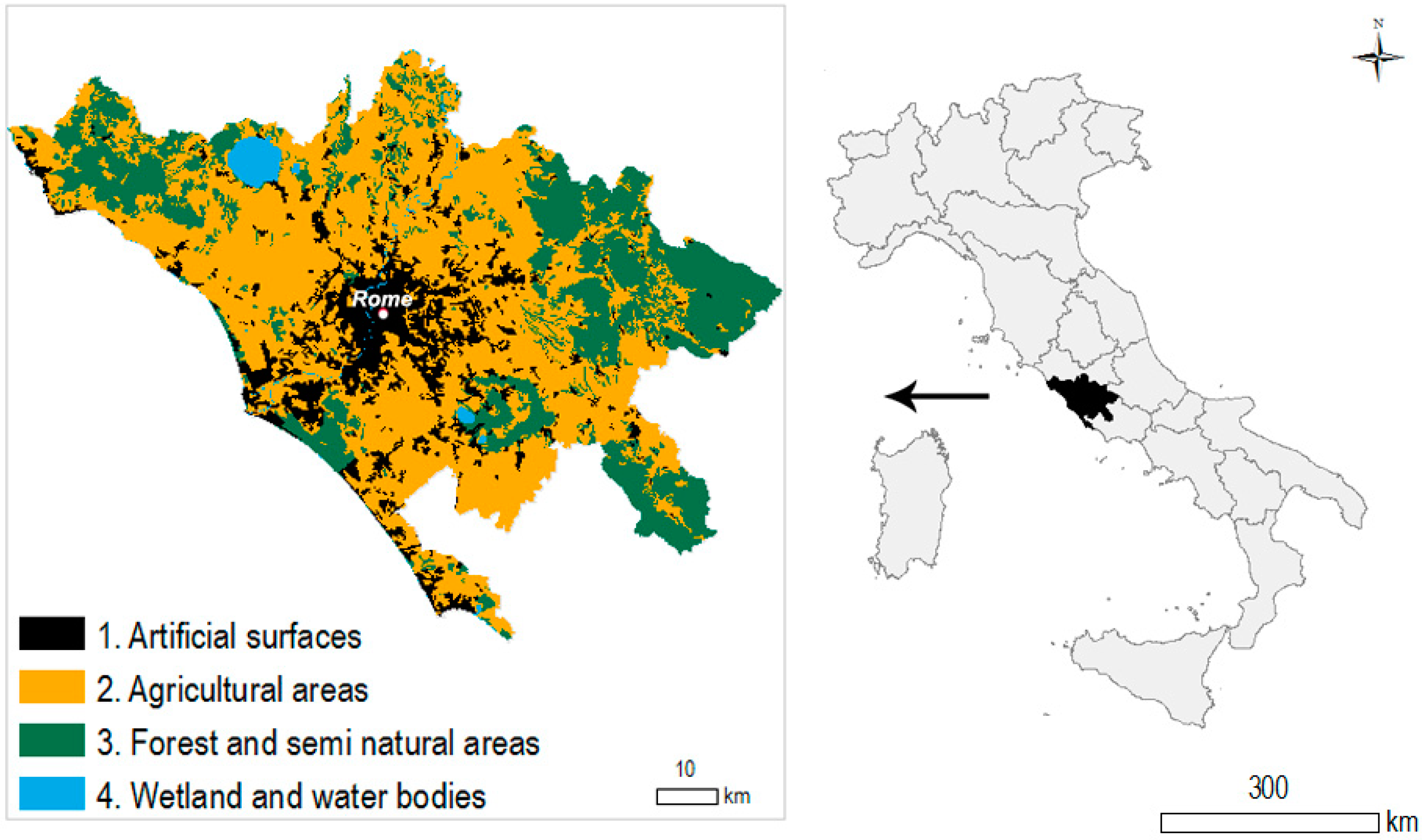
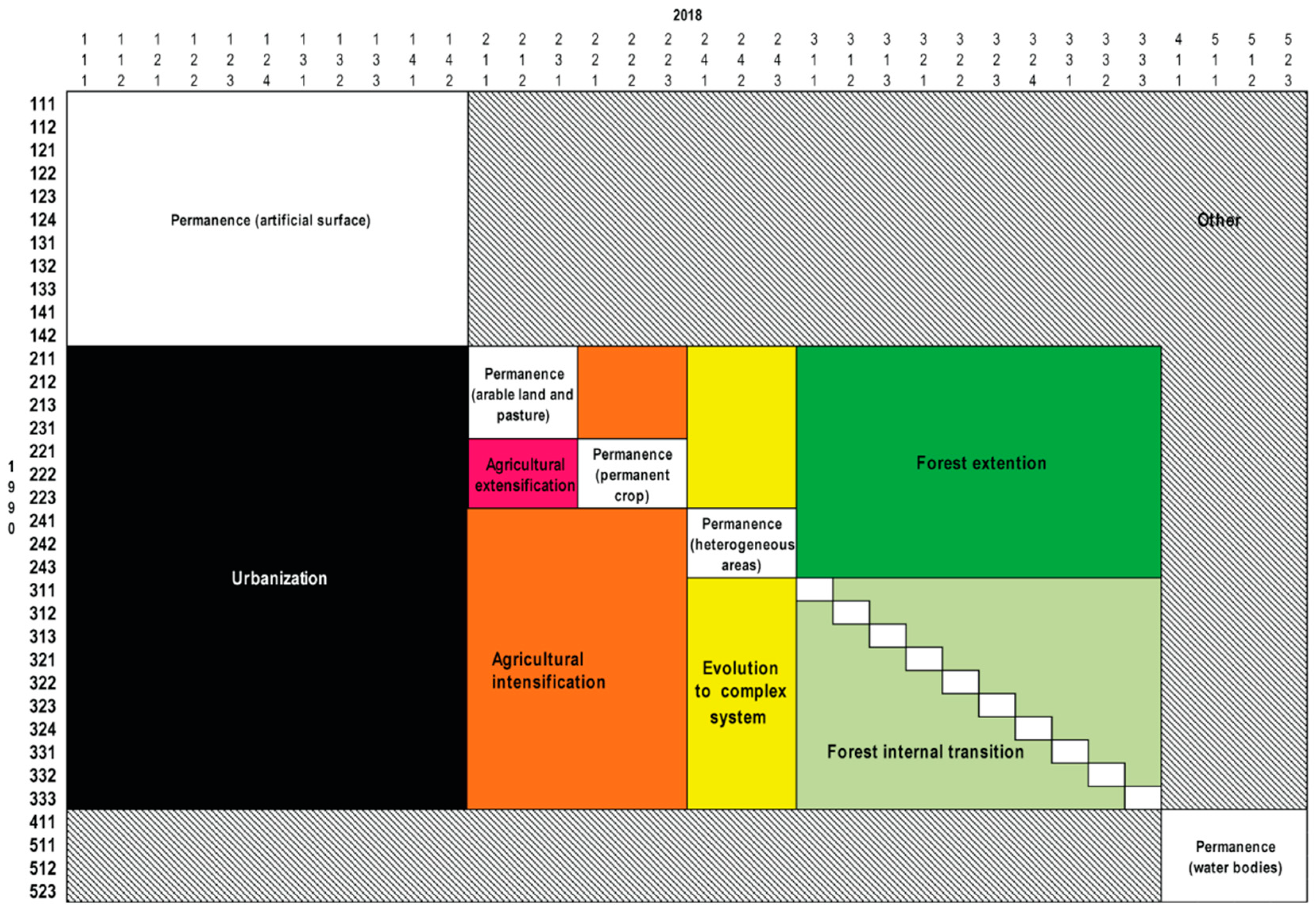

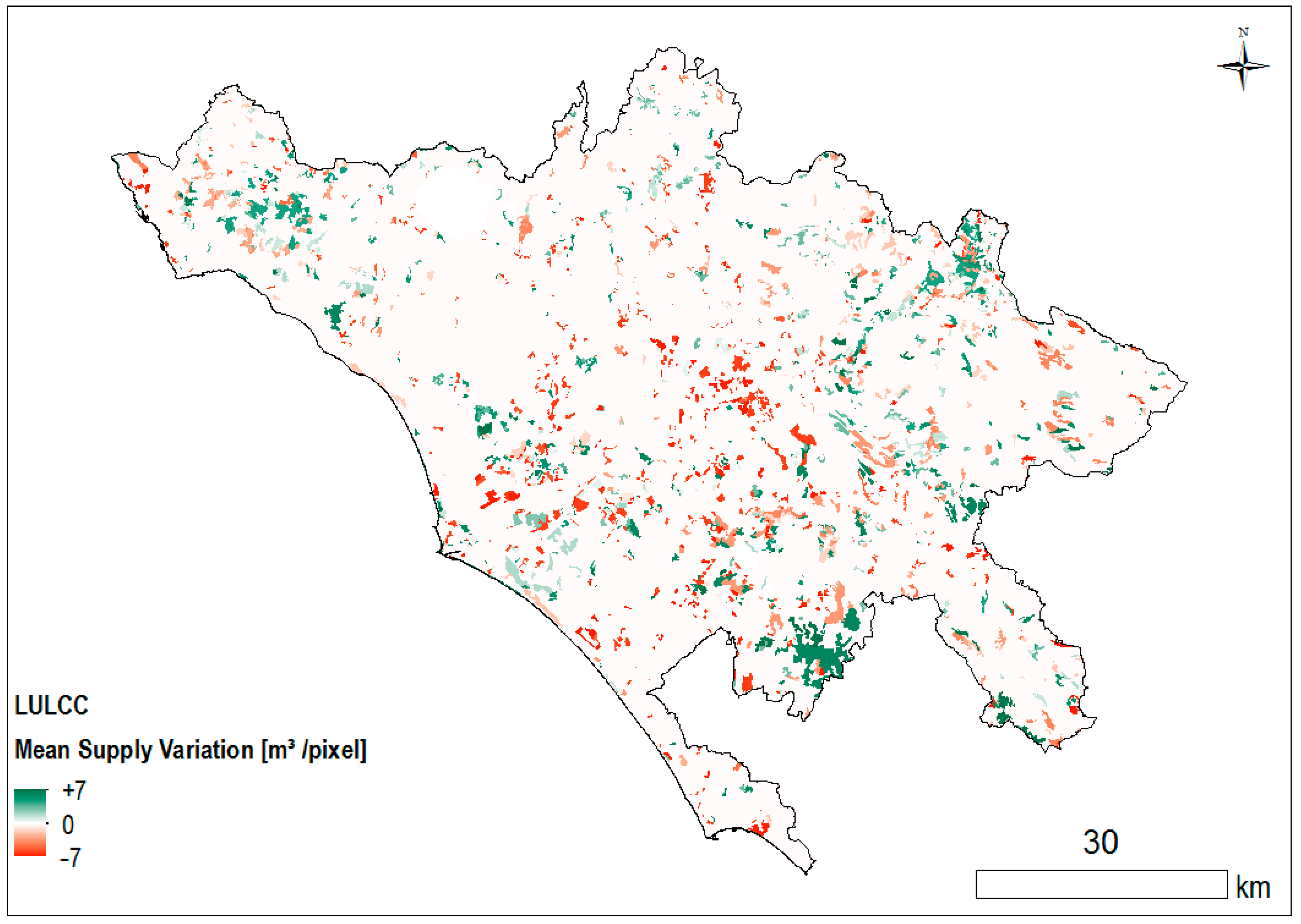
| LULCC Transition Categories | Area (ha and %) | ES Supply Variation (m3) | ES Supply Mean Variation (m3/ha) |
|---|---|---|---|
| Agricultural extensification | 694 (0.1%) | 46,903 | 68 |
| Agricultural intensification | 9419 (1.9%) | 206,716 | 22 |
| Evolution to complex system | 23,460 (4.4%) | 410,830 | 3 |
| Forest extension | 5965 (1.1%) | 805,628 | 135 |
| Forest internal transition | 25,333 (4.7%) | 685,310 | 27 |
| Urbanization | 12,126 (2.3%) | −3,236,852 | −267 |
| Other changes | 3257 (0.6%) | 684,360 | 212 |
| Permanence | 455,538 (85.0%) | 217,675 | 0.4 |
| Total | 535,792 (100%) | −513,065 | - |
| Corine Land-Cover Class | Area | Supply | ||||||
|---|---|---|---|---|---|---|---|---|
| 1990 | 2018 | ∆ 2018–1990 (ha) | ∆ 2018–1990 (%) | 1990 | 2018 | ∆ 2018–1990 (t) | ∆ 2018–1990 (%) | |
| 211 | 162,394 | 148,701 | −13,693 | −9 | 2,252,571 | 2,062,638 | −189,932 | −8 |
| 221 | 14,557 | 9620 | −4937 | −51 | 154,540 | 102,127 | −52,413 | −34 |
| 222 | 28,423 | 28,282 | −141 | 0 | 41,184 | 40,980 | −204 | 0 |
| 223 | 4495 | 3166 | −1329 | −42 | 24,657 | 17,368 | −7289 | −30 |
| Total | 209,869 | 189,769 | −20,099 | −11 | 2,472,952 | 2,223,114 | −249,838 | −11 |
| Transition | Agricultural Productionvariation (ton/ha) | Agricultural Production Variation (%) | Flood Mitigation Variation (m3) | Flood Mitigation Variation (%) |
|---|---|---|---|---|
| Agricultural extensification | +4,325 | +2 | +46,903 | +6 |
| Evolution to complex system | −214,596 | −86 | +461,793 | +61 |
| Agricultural intensification | +55,410 | +22 | +218,151 | +29 |
| Other changes | +12,728 | +5 | +227,198 | +30 |
| Permanence of permanent crop | −9,311 | −4 | +218,095 | +29 |
| Permanence of arable land and pasture | +14,054 | +6 | −45,396 | −6 |
| Forest extension | −16,014 | −6 | +119,850 | +16 |
| Urbanization | −96,436 | −39 | −2,005,228 | −264 |
Disclaimer/Publisher’s Note: The statements, opinions and data contained in all publications are solely those of the individual author(s) and contributor(s) and not of MDPI and/or the editor(s). MDPI and/or the editor(s) disclaim responsibility for any injury to people or property resulting from any ideas, methods, instructions or products referred to in the content. |
© 2023 by the authors. Licensee MDPI, Basel, Switzerland. This article is an open access article distributed under the terms and conditions of the Creative Commons Attribution (CC BY) license (https://creativecommons.org/licenses/by/4.0/).
Share and Cite
Marino, D.; Palmieri, M.; Marucci, A.; Soraci, M.; Barone, A.; Pili, S. Linking Flood Risk Mitigation and Food Security: An Analysis of Land-Use Change in the Metropolitan Area of Rome. Land 2023, 12, 366. https://doi.org/10.3390/land12020366
Marino D, Palmieri M, Marucci A, Soraci M, Barone A, Pili S. Linking Flood Risk Mitigation and Food Security: An Analysis of Land-Use Change in the Metropolitan Area of Rome. Land. 2023; 12(2):366. https://doi.org/10.3390/land12020366
Chicago/Turabian StyleMarino, Davide, Margherita Palmieri, Angelo Marucci, Mariangela Soraci, Antonio Barone, and Silvia Pili. 2023. "Linking Flood Risk Mitigation and Food Security: An Analysis of Land-Use Change in the Metropolitan Area of Rome" Land 12, no. 2: 366. https://doi.org/10.3390/land12020366
APA StyleMarino, D., Palmieri, M., Marucci, A., Soraci, M., Barone, A., & Pili, S. (2023). Linking Flood Risk Mitigation and Food Security: An Analysis of Land-Use Change in the Metropolitan Area of Rome. Land, 12(2), 366. https://doi.org/10.3390/land12020366








